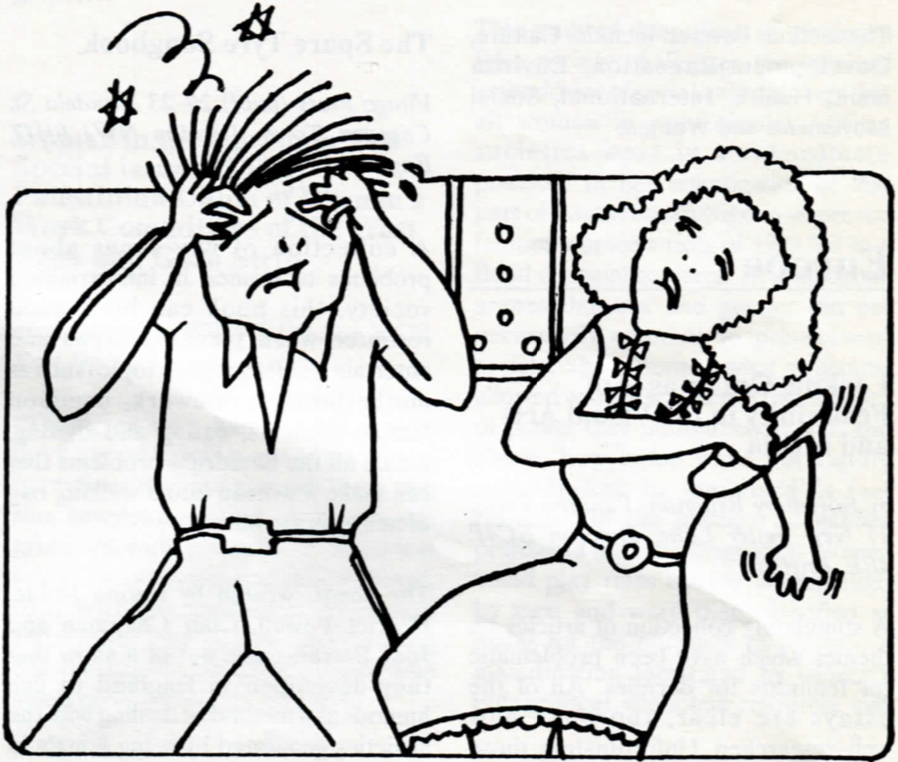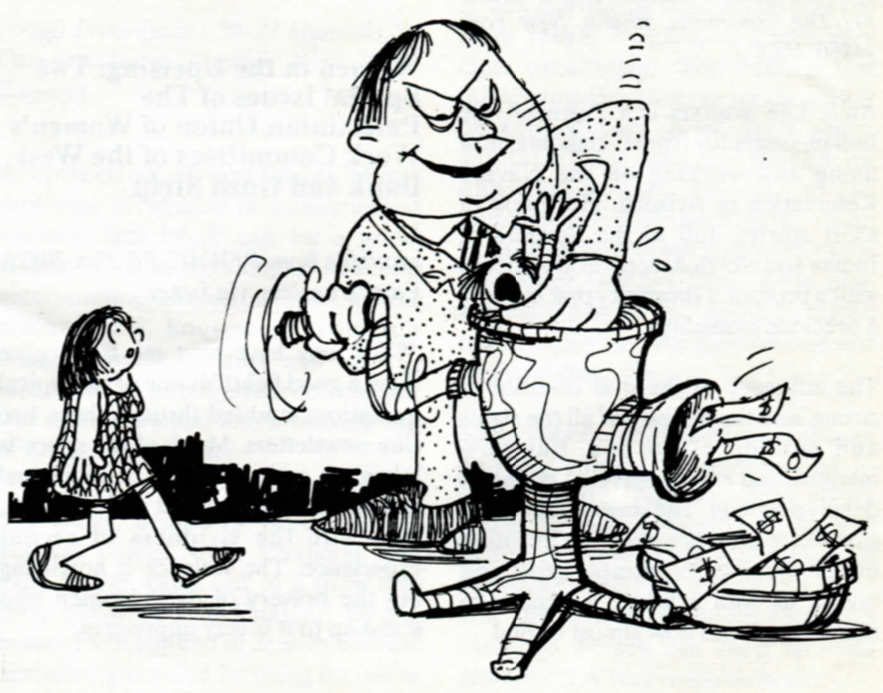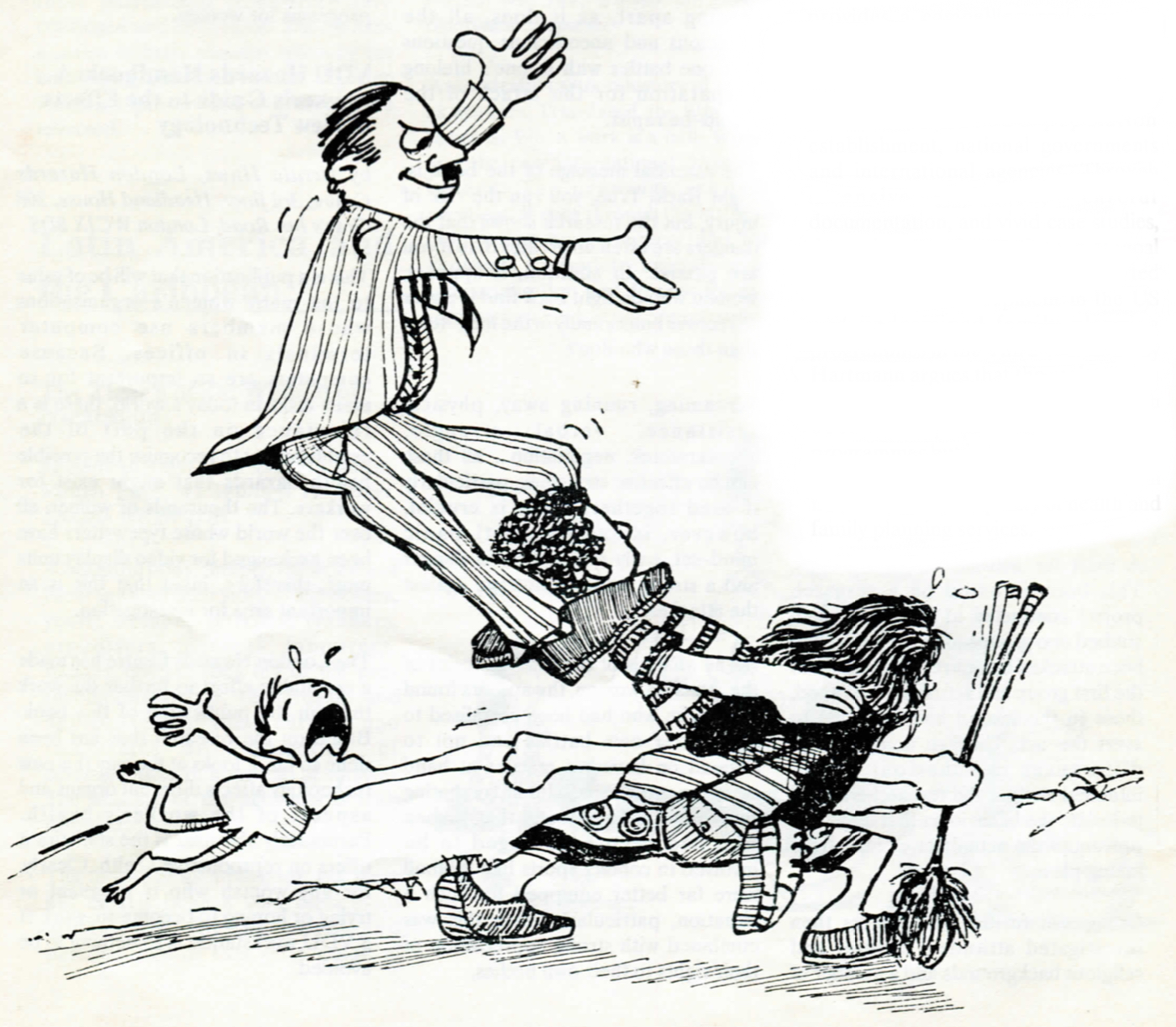Asia and the Pacific
Daughters in Industry: Work Skills and Consciousness of Women Workers in Asia
edited by Noeleen Heyser, Asian and Pacific Development Centre, Pesiaran Data, P.O. Box 12224, 50770 Kuala Lumpur, Malaysia
A very comprehensive volume of case studies from ten countries in Asia. Bangladesh, China, Korea, Laos, Malaysia, Pakistan, the Philippines, Singapore, Sri Lanka and Thailand are all the focus of substantive studies by an impressive collection of scholars.
Topics covered include rural industrialisation and home-based production, labour-intensive industrialisation (covering, Bangladesh, Pakistan, Sri Lanka and Thailand), labour organisations and labour actions, and the impact of the shift to high technology on women in South Korea and Singapore.
The case studies are based on first hand research as well as historical, economic and sociological analysis. This is a most important book for those interested in the future of women workers as well as present realities.
Men, Women and Violence: A handbook for Survival
published by the Association of Women for Action and Research (AWARE) and the Singapore Association of Women Lawyers (SAWL) available from AWARE, Tanglin P.O. Box 244, Singapore 9124
A model publication. In every country, similar booklets should be produced and distributed throughout schools, colleges and communities.
This little book is extremely clear, well- organised and well- illustrated. It goes through all the forms of violence against women, rape, sexual harassment, incest, child abuse, etc., etc...
In simple language, point by point, it explains what acts fall under these titles and then what a victim or potential victim can do. At the back of the book is a long list of the agencies which can be called upon for help in different cases.
In each section, it explains both the legal and social aspects of the various topics, but m such an uncluttered way that makes comprehension very easy. It goes into the definition of the different offenses, the punishment established for them and the possible consequences for victims.
Humorous illustrations help to lighten an otherwise unsavoury subject, and encourage a positive attitude to the problem. This book was produced for the Task Force for the Prevention of Violence Against Women Singapore Council of Women's Organisations (SCWO) for their project Stop Violence Against Women.

Sati, (special edition of Seminar journal)
available from P.O. Box 338, New Delhi-1, India
Sati (or widow immolation) is a phenomenon far removed from the experience of most people outside India. Like female circumcision in Africa however, it is a practice that sheds light on the nature of male-female interactions that seem much more benign.
This journal, containing contributions from noted scholars and activists in India, is well worth examination by non-Indians. When this single phenomenon of Sati is taken apart by the various skilled analysts, a very clear picture of the elements of modern Indian social life emerges.
Articles include one on Sati in history by renowned historian Romila Thapar, another on the politics of widow immolation by Sudesh Vaid, a third called Perpetuating the Myth, by Kumkum Sangari as well as a legal analysis entitled, Saint, Victim or Criminal by Vasudha Dhagamwar and a series of interviews with village women on the issue of sati. The introduction is by Kamla Bhasin and Ritu Menon.
The Other Picture: A Resource Guide to Audiovisual Material
published by CENDIT, D-1, Soami Nagar, New Delhi - 110017, India
This very valuable catalogue of material on alternative issues ranges far and wide but lists mainly films, videotapes and slide productions made in the third world. Because of the source, the focus is mainly on India, but the large number of useful productions listed make it clear that there exists a great deal of audiovisual material which can be very helpful to development groups, activists and educational institutions.
The sections covered include: Culture, Development,Education, Environment, Health, International, Social Movements and Women.
Europe
Looking On: Images of Femininity in the visual Arts and Media
by Rosemary Betterton, Pandora Press, 11 New Fetter Lane, London EC4P 4EE, England
A stimulating collection of articles on themes which have been problematic for feminists for decades. All of the essays are clear, thorough and well-researched. Unfortunately, those on advertising and pornography do not add much to our conceptualisation of these issues. However they are insightful and make the book a useful resource for teachers, workshop leaders and general readers.
The sections dealing with the visual arts are fresher; they probe into areas that are well worth exploration. In addition, the writing in all the pieces sparkles with intelligence and scholarship.

The Spare Tyre Songbook
Virago Press (publ) 20-23 Mandela St, Camden Town, London NWl OHQ, England
A collection of wry songs about problems of women in industrialised society, this book can be a good resource when planning shows and entertainments. Songs on topics such as motherhood, housework, common female ailments, eating and dieting, men... all the humdrum problems that can make a woman into a walking bag of neurosis are here.
The songs, written by Katina Noble, Harriet Powell, Clair Chapman and Judy Farrar, came out of a show that they developed in England to use humour as a method of dealing with the anxieties generated by being female in that kind of society. With the domination of Western media, far more of us may be susceptible to these pressures, so the Spare Tyre song book may turn out to be quite widely applicable.
Georgie Porgie: Sexual Harassment in Everyday Life
by Sue Wise and Liz Stanley, Pandora Press, 11 New Fetter Lane, London EC4P4EE, England
A very convincing book which puts the term sexual harassment under very close examination. The thesis is that this commonly- used phrase should not be applied only to incidents where sexual attentions are forced on unwilling women, but also to the mundane events of everyday life where women are constantly reminded of the role which they are expected to play, are manipulated or nagged or teased into compliance with their subordinate and trivialised status.
Slices out of everyday life are taken out and put under the microscope to demonstrate the consistent strain which is put on women to give in and accept the role which the folklore of industrial society has dictated for them. But the writers maintain that with vigilance women can keep up some resistance. A very readable book.
Canada and the USA
The Laughing Baby: Remembering Nursery Rhymes and Reasons
by Anne Scott, Bergin and Garvey Publishers, 670 Amherst Road, Granby, MA 01033, USA
A sweet little collection of nursery rhymes from all round the world. Translations and often music are provided as well as guide lines for their use in games and clapping activities.
What makes the book particularly valuable is the deliberate way it points attention to childcare traditions that are dying out in industrialised society. In a simply, but convincingly, written introduction, Scott explains the rationale for reverting to a form of upbringing that stresses touch, laughter and fun. A nice little gift for mothers.
The Sun is Not Merciful
By Anna Lee Walters, Firebrand Books, 141 The Commons, Ithaca, New York 14850, USA
Anna Lee Walters is a Pawnee/Otoe Indian, originally from Oklahoma, now living and working on the Navajo Reservation in Arizona. Her book of short stories, full of the flavours of Indian and North American life, speaks with a profound simplicity that conveys a precious humanity.
The influence of the oral tradition is strong, and the honesty of all the sights and sounds of an old, but now marginalised and pauperised people is deeply poignant. The sheer talent of the storyteller creates something beautiful out of whatever tawdriness exists and invites us with a subtle summons to marvel at glories now almost buried.
Africa and the Middle East
Sauti ya Siti (magazine)
Tanzania Media Women's Association PO Box 6143, Dares Salaam, Tanzania
A new magazine of this name has been launched by the Tanzania Media Women's Association. Taking its name from a woman singer/poet of Tanzania, who rose from humble beginnings to become a legend in the early years of this century, the magazine's aim is to provide a voice for the broad range of issues which affect Tanzanian women.
The first issue, 36 pages long, include a fascinating profile of its namesake, Siti, two articles on women workers, one on house girls (domestic servants), another on South African women, a short story, as well as a number of other items. Printed in black and white, it includes a number of photographs and graphics.
Women in the Uprising: Two Special issues of The Palestinian Union of Women's Work Committees of the West Bank and Gaza Strip
available from PFWAC, PO Box 20576, East Jerusalem, via Israel
"They may have hurt me but I gave them a good fight!"i s one of the typical quotations studded through these two slim newsletters. Much of the space is taken up with accounts of individual acts of resistance against military raids, told with the vividness of recent experience. The violence is horrifying but the bravery of these women who stand up to it is very impressive.
The Circumcision of Women: A Strategy for Eradication
by Olayinka Koso-Thomas, Zed Books Ltd, 57 Caledonian Road, London Nl 9BU, England
A very detailed 20-year programme for the eradication of female circumcision. Based on extensive research in Sierra Leone, this medical doctor has set down a thoroughly developed model which can be adapted to other countries. More than this, she includes a wealth of statistical material on the health effects of the practice. These, based on interviews and health records, can be powerful arguments in the swaying of the health establishment to take seriously the need for mounting campaigns.
Male Daughters, Female Husbands: Gender and Sex in an African Society
by Ifi Amadiume, Zed Books Ltd, 57 Caledonian road, London N l 9BU, England
This study of the politics of gender in Igbo society challenges the received orthodoxies of social anthropology that all women in pre-colonial African societies were in a subordinate position. In her investigation of that part of Southeastern Nigeria where the famous women's riots of 1929 led to a flood of social research, Ifi Amadiume argues that sex and gender did not necessarily coincide in pre-colonial society. She examines what structures allowed women to achieve the measure of power they undoubtedly did, and shows how roles were not rigidly masculinised or feminised (a fact reflected in the absence of gender prefixes in the Igbo language). Women could play roles usually monopolised by men and were then classified as males for the purposes of power - a classification facilitated by women's independent economic resources and the existence of a strong goddess-focussed religion.
The colonial period brought economic changes that undermined women's monopoly over the sale of certain foods and reduced the economic sanctions they could wield over men. The Christian Church attacked the goddess religion and those customs that enhanced women's status. And the colonial administration's appointment of male warrant chiefs and courts, reduced women's political roles.
In the modern period, Ifi argues that these patriarchal tendencies have continued and intensified. She outlines a series of basic changes whereby the continuing deterioration in Nigerian women's power and status can be reversed.
Latin America and the Caribbean
The Tiger's Milk: Women of Nicaragua
by Adriana Angel and Fiona Macintosh, Virago Press, 41 William IV Street, London WC2N 4DB
A beautiful book. Simply, the women of Nicaragua tell their stories: old women, young women, activists, teachers, organisers, mothers, labourers, Indians, blacks. They tell of the pre-revolutionary days, of hardship and deprivation, of their current and sometimes dire struggles, of determination, of hope and of survival. The honesty of the accounts is truly inspiring.
This looks like a simple book. But there has clearly been a very meticulous editing job, for the voices and personalities of this wide range of
women to emerge so clearly. The form of the book is excellent, short biographies accompanied by large black and white photographs in a very attractive format.
Lovely to thumb through over and over again, when your own spirits flag.
Cuando Trabajar es un Infierno: Las mujeres y la nueva division internacional del trabajo (2 volumes)
published by CIPAF, Benigno Filomeno Rojas No 307, Santo Domingo, Dominican Republic
A wonderful cartoon history of women as workers. Translated, the title of this series is: When work is a hell: Women and the new international division of labour. The drawings are truly excellent. It goes through the history of colonialism and conquest and then proceeds to modern capitalism and industrialisation and to new forms of international industrial organisation.
This series should be immediately translated into English and scattered by low-flying aircraft all over the Caribbean and the rest of Latin America. A fantastic educational tool.

You Can't Drown the Fire: Latin American Women Writing in Exile
edited by Alicia Partnoy, Cleis Press, PO Box 8933, Pittsburg Pensylvania, USA
Stripped day by day Of all my garments, dry naked tree, m my solitary withered mouth fresh words will still blossom
by Alaide Foppa (disappeared)
It is difficult to write a notice about this book which is better than that which appears on the back cover. So here it is:
The voice of exile ricochets off endless walls, never losing its resonance or shattering the walls. And the surfaces which reproduce its powerful sound are the rock of natural canyons, the streets of strange cities, human skin, the heart's muscle. Exile: a painful phenomenon of our times. Women in exile: certainly the epicentre, those who so often receive the greatest weight while sustaining others - and themselves - in a maddening spiral of imposed change. I cannot think of anyone who could have done a better job of gathering up these voices: for Alicia Partnoy is, herself, very much a part of this history. Listen to these women: in essay, narrative, poetry, testimony, song. Learn, through their words, what it means to leave your homeland and take it with you at one and the same time.
Margaret Randall
International
Stopping Rape: Successful Survival Strategies
by Pauline B. Bart and Patricia H. O'Brien,The Pergamon Press, Headington Hill Hall, Oxford OX3 OBW, England
A must for activist women's groups. This book is based on a research project conducted in the USA which studied two groups of women who had been attacked by rapists. The women in the first group had actually been raped, those in the second had managed to avert the act. Through analysing the differences in behaviour of the intended victims, the researchers tried to isolate the behaviours that may have prevented the actual act of rape from taking place.
Going still further, the writers then investigated attitudes, cultural and religious backgrounds and a number of other factors in order to determine if there are determinants within socialisation practices which may precondition women to become rape victims.
The final result is a very suggestive piece of work which points to concrete ways in which women can be trained and oriented so as to prevent themselves being vulnerable to rapists. Only other trained social scientists can properly attest to the methodology employed. However, to the lay feminist applying mere commonsense, the material in this book looks like gold, teasing apart, as it does, all the conscious and unconscious questions that one battles with in one's lifelong preparation for the attack of the would-be rapist.
The essential message of the book is: Fight Back. True, you run the risk of injury, but the research shows that the dangers are often no greater than if you are passive. In addition, it appears, women who do fight back find it easier to recover emotionally m the long-term than those who don't.
Screaming, running away, physical resistance, verbal struggle, counterattack, negotiation... all these can be effective strategies, particularly if used together. What is crucial, however, is an alert, anti-panic mind-set, early recognition of danger and a strong sense of outrage against the attacker.
In the analysis of the case-histories of the attacked women, the authors found that those who had been socialised to fight their own battles and not to depend on having a rescuer at hand were the most successful in combating rape attacks. They found that women who had been encouraged to be involved in contact sports Uke football were far better equipped for such a situation, particularly when this was combined with strong appreciation of their rights to their own bodies.
Essentially, what was most important was the will not to be raped, though this cannot always protect a woman against a plurality of armed attackers.
Because Bart and O'Brien's study focuses so steadily on the concrete experiences of their subjects, the reader confronts situations which, in her normal life, remain in the realm of vague horrors. In calmly analysing the reactions of others, she can devise game-plans for possible danger-situations of her own. This book can be an invaluable basis for the preparation of self- protection training programs for women.
VDU Hazards Handbook: A worker's Guide to the Effects of New Technology
by Ursula Huws, London Hazards Centre, 3rd floor, Headland House, 308 Gray's Inn Road, London WCDCSDS
This is a publication that will be of value to the many women's organisations whose members use computer terminals in offices. Because computers are so important for so many tasks in today's world, there is a reluctance on the part of the establishment to recognise the possible health hazards that might exist for workers. The thousands of women all over the world whose typewriters have been exchanged for video display units must, therefore, insist that this is an important area for investigation.
The London Hazards Centre has made a creditable effort to further the work through the publication of this book. Based on the research that has been done so far, it looks at the way this new technology affects different organs and aspects of the worker's health. Particularly alarming is the statistics it offers on reproductive health. Clearly, for any woman who is pregnant or trying or hoping to become so, work at a VDU workstation is something to be avoided. For others, there is the clear need for conditionality to be attached to use. Length of time at the VDU, seating facilities, lighting, noise, all of these must be controlled.
The book refers to battles fought in various places to institute these controls and offers guidelines for workers to organise so as to insist on a proper working environment.
The book was written for British readers, but it is clearly relevant to women in offices all over the world.
The Revaluation of Women's Work
by Sheila Lewenhak, Croom Helm Ltd, Provident House, Burrell Row, Beckenham, Kent, BR3 lAT, England
A massive compilation of data on the value of women's work globally. Every conceivable fragment of women's existence is overturned to see if it sheds light on the issue, from dowry to water provision to put-out work to successful businesswomen in England..What the book lacks, however, is an introduction to give the reader assistance in going through the welter of information provided.

Reproductive Rights and Wrongs: The Global Politics of Population Control and Contraceptive Choice
by Betsy Hartmann, Harper and Row Publishers, 10 East 53rd St, New York, N.Y. 10022, USA
To quote an earlier commentator, the women's movement has been waiting for such a book for a long time. It provides a compelling and urgently needed critique of the economic, political, health and human rights consequences of population control as practiced by the US population establishment, national governments and international agencies. Through extensive research, careful documentation, and vivid case studies, the author reveals how the narrow goal of reducing birth rates has distorted contraceptive development in the US and undermined family planning programmes in the Third World. Betsy Hartmann argues that the real solution to the population problem lies not in coercive population control programmes but m the improvement of living standards, the position of women in society, and the quality of health and family planning services.

